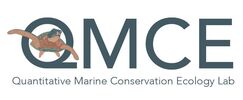Investigators: Susan Piacenza, Jackson reimer, Chris Noren, Emma Roberto, Tabitha Siegfried
Florida’s gulf fishing piers serve as artificial habitat for sea turtle populations inhabiting the northern Gulf of Mexico. However, sea turtle recreational bycatch at fishing piers has increased at Navarre Beach Fishing Pier (NBFP) since 2016. To understand patterns of pier occupancy and habitat usage, as well as to understand what is driving sea turtles using fishing piers as habitat, we conducted in-water stereo-video camera surveys of sea turtles at five local fishing piers, and gathered environmental data locally. We also collected data of environmental parameters using georeferenced data in ArcGIS and statistically evaluated which environmental variables best predicted bycatch using the information-theoretic approach. Forty-one sea turtle observations were recorded during in-water surveys with most observations occurring at NBFP (n=34) and no observations occurring at Fort Pickens Pier (FP) and St. Andrew’s State Park Pier (SA). Additionally, sessile invertebrates were the dominant fouling taxa at most piers; however, the pier at St. Andrew's were primarily covered by algae species. The fishing piers serve as an artificial habitat for juvenile and subadult Green, Loggerhead and Kemp’s ridley sea turtles, and green sea turtles were the most frequently observed species. For green sea turtles, we found that proximity to the nearest seagrass bed and tonnage of artificial reef in proximity to piers best predicted bycatch. These results suggest future artificial reef deployment and pier installations should consider the potential ecological impact on sea turtles to mitigate future recreational bycatch.
Florida’s gulf fishing piers serve as artificial habitat for sea turtle populations inhabiting the northern Gulf of Mexico. However, sea turtle recreational bycatch at fishing piers has increased at Navarre Beach Fishing Pier (NBFP) since 2016. To understand patterns of pier occupancy and habitat usage, as well as to understand what is driving sea turtles using fishing piers as habitat, we conducted in-water stereo-video camera surveys of sea turtles at five local fishing piers, and gathered environmental data locally. We also collected data of environmental parameters using georeferenced data in ArcGIS and statistically evaluated which environmental variables best predicted bycatch using the information-theoretic approach. Forty-one sea turtle observations were recorded during in-water surveys with most observations occurring at NBFP (n=34) and no observations occurring at Fort Pickens Pier (FP) and St. Andrew’s State Park Pier (SA). Additionally, sessile invertebrates were the dominant fouling taxa at most piers; however, the pier at St. Andrew's were primarily covered by algae species. The fishing piers serve as an artificial habitat for juvenile and subadult Green, Loggerhead and Kemp’s ridley sea turtles, and green sea turtles were the most frequently observed species. For green sea turtles, we found that proximity to the nearest seagrass bed and tonnage of artificial reef in proximity to piers best predicted bycatch. These results suggest future artificial reef deployment and pier installations should consider the potential ecological impact on sea turtles to mitigate future recreational bycatch.
All sea turtle species in US waters are on the US Endangered Species List. Since the in-water research conducted by the Piacenza QMCE Lab on endangered species is remote and encounters with animals are less than 5 minutes, we do not require scientific research permits from federal or state agencies. We have consulted with the relevant state and federal agencies to ascertain if scientific research permits are required. If you encounter sea turtles or other endangered marine species in the wild, do not approach them or follow them, as this could result in unintentional harm. Please see the NOAA webpage Marine Wildlife Viewing Guidelines for best practices.
